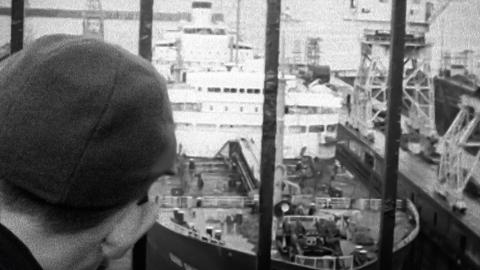The South West Film and Television Archive (SWFTA) is the regional film archive for the South West of England. Established in 1993, SWFTA's core collection comprises of the combined programme libraries of Westward Television and TSW (Television South West). The archive also cares for a significant number of donated film collections, both amateur and professional, dating back to the early 1900s.
This film is part of Free

School Visit to Falmouth
Pupils from a Teddington school visit the town hall and the docks of Falmouth.
From the collection of:

Overview
Pupils from a Teddington school visit Falmouth Town Hall and the mayor, Francis Offord. Falmouth is the world's third largest natural deepwater harbour after Rio de Janeiro and Sydney and is the first and last port of call on one of the world's busiest shipping lanes known as the Western Approaches. The port serves as an international bunkering or refuelling port because of restrictions on fuel emissions in Europe.
The natural haven for shipping was originally called Porhan Withe meaning port of shelter. Henry VIII built Pendennis Castle in 1540 at the entrance of the Fal estuary and Carrick Roads' body of water and appointed its first governor Sir John Killigrew to protect the land from attack. The settlement around the Killigrew family estate at Arwenack grew into the town of Falmouth. From 1688 Falmouth operated as a Post Office packet boat station. Packet boats ran mail and bullion to outposts of the British Empire and were vital in keeping Britain's trading routes open. The docks continued to develop in the nineteenth century and ships carried Cornwall's mining exports around the world.
Related

Tour up the River Fal Tour up the River Fal
Current affairs 1977 7 mins Location: Falmouth
A boat trip from Falmouth to Tolverne Cottage takes in the sights along the banks of the River Fal.

Tinkerbelle Tinkerbelle
Current affairs 1965 12 mins Location: Falmouth
Newsman Robert Manry fulfils his lifelong dream of sailing solo across the Atlantic Ocean from Falmouth to Falmouth.

Robin Knox-Johnston and the Golden Globe Win Robin Knox-Johnston and the Golden Globe Win
News 1969 5 mins Location: Falmouth
Merchant Officer Robin Knox Johnston is the first person ever to complete a solo single-handed round-the-world yacht race.

Scenes on the Cornish Riviera Scenes on the Cornish Riviera
Advert 1912 19 mins Silent Location: Plymouth
From Saltash to St Ives, a whirlwind tour of Edwardian Cornwall.

In and around Falmouth In and around Falmouth
Amateur film 1950 4 mins Silent Location: Falmouth
A family enjoys a trip to the Green Bank Hotel in Falmouth and indulges in some water activities.

Holiday to Cornwall Holiday to Cornwall
Amateur film 1953 10 mins Silent Location: Falmouth
A boat trip outing is filmed during a family holiday to Falmouth.

All We Imagine As Light - Exclusive Q&A All We Imagine As Light - Exclusive Q&A
Short interview 2025 28 mins
Payal Kapadia discusses her Cannes prize-winning and Bafta-nominated drama with Ashanti Omkar.

Khichdi Khichdi
Animation & Artists Moving Image 2023 16 mins
The interwoven stories of four best friends who reunite in the UK, thirty-five years after training together as nurses during their teens in Ferozepur, Punjab.

Dr XYZ: A Medical Drag Transthology Dr XYZ: A Medical Drag Transthology
Documentary 2023 15 mins
A satirical take on the healthcare service announcements of the 1960s and 70s.

Every Moment Counts Every Moment Counts
Animation & Artists Moving Image 2023 9 mins
A short animation that offers a window into the world of children’s palliative care.

Police Story: Panel Discussion Police Story: Panel Discussion
Inside Film 2024 24 mins
Panel discussion on Jackie Chan's 1985 action classic Police Story, with Chase Armitage, Sam Mak and Jadey Duffield.

China O'Brien: The Reunion China O'Brien: The Reunion
Documentary 2024 60 mins
Cynthia Rothrock, Richard Norton and Keith Cooke reunite three decades on from the groundbreaking martial arts classic.